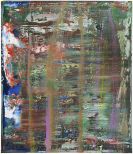
Karl Otto Götz
1914 Aachen
2017 Niederbreitbach
Karl Otto Götz was born in Aachen on 22 February 1914. He started painting when he went to secondary school in 1924. In 1930 he began to create abstract paintings, shortly afterwards he experimented with collages. He had to give up his second passion soar when painting became difficult for him due to the National Socialist's take-over.
Götz got by selling landscape paintings to tourists, but was banned from painting and exhibiting due to his abstract splash paintings and surrealistic works. Götz was drafted, but was able to study further, to meet with colleagues and to make important connections. At the end of the war Götz, who was mainly based in Norway, got off lightly when an English acquaintance answered for him.
His early works went up in flames in Dresden. In December 1945 he married his friend Anneli Brauckmeyer.
During the late 1940s abstract compositions, surealistic photo-experiments and abstract-figurative monotypes were executed. He abandoned figurative art altogether in 1949 and was the first German to join the "CoBrA" group. After co-founding the Frankfurt "Quadriga", an artist group representing a type of Tachism influenced by Wols and Automatism, his work changed drastically in 1952: the forms, which until now had still been well-defined, were replaced by a new, more dynamic style in a special raking technique which the artist still uses.
Each work is prepared over a long period in an art theoretic process - a gradual development of the image, which is often reflected in numerous sketches and gouaches produced over a number of years. There are three fast working processes: first the artist applies dark paint onto a light background with a paintbrush, then he partly removes this paint again with a "rake", a type of spatula. Finally he softens the harsh contrast between light and dark areas with a dry paintbrush.
His early metamorphosis-like style, which awakens associations with insects and birds, changed during the 1950s to a more metaphorical language with a harmony between colour and rhythm.
Götz was a co-publisher of the magazine "Meta" from 1948 to 1953 and taught as a professor at the Kunstakademie in Düsseldorf between 1959 and 1979.
Götz has been living and working in Wolfenacker in the Westerwald since 1975. Karl Otto Götz is one of the most important members of the German Informel and soon enjoyed international recognition, for example at the "documenta II" in 1959.
During the two decades in which the artist taught at the Kunstakademie in Düsseldorf Götz influenced artist personalities as diverse as HA Schult, Sigmar Polke and Gerhard Richter.
Related artists: Bissier, Julius Heinrich | Bott, Francis | Brodwolf, Jürgen | Brüning, Peter | Buchheister, Carl | Caspar-Filser, Maria | Cavael, Rolf | Corpora, Antonio | Dahmen, Karl Fred | Fautrier, Jean | Gaul, Winfred | Girke, Raimund | Hartung, Hans | Hartung, Karl | Hoehme, Gerhard | Imai, Toshimitsu | Jenkins, Paul | Jorn, Asger | Kirkeby, Per | Kricke, Norbert | Mathieu, Georges | Matschinsky-Denninghoff, Martin und Brigitte | Michaux, Henri | Music, Zoran | Nay, Ernst Wilhelm | Nitsch, Hermann | Prachensky, Markus | Rainer, Arnulf | Santomaso, Giuseppe | Schultze, Bernard | Schumacher, Emil | Sonderborg, K.R.H. (d.i. Kurt R. Hoffmann) | Soulages, Pierre | Staudacher, Hans | Stöhrer, Walter | Tàpies, Antoni | Thieler, Fred | Tinguely, Jean | Tobey, Mark | Trier, Hann | Werner, Theodor | Wessel, Wilhelm | Westpfahl, Conrad | Winter, Fritz | Wols, (d.i. Wolfgang Schulze) | Wou-Ki, Zao | Wunderlich, Paul | Zimmer, Bernd

Would you like to sell a work by Karl Otto Götz?
Infos for sellerART MARKET:

Abstraktes Bild
Oil on canvas, 1989
Estimated price 1.500.000
More offers >






